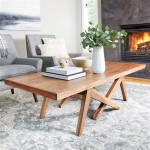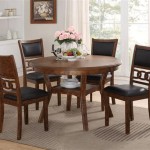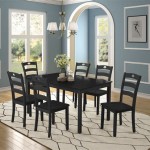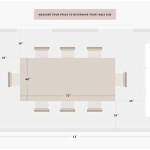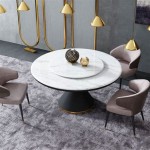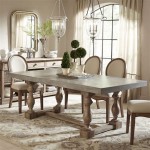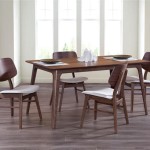Kitchen Ideas With Dining Table: Integrating Functionality and Style
The kitchen, traditionally a space dedicated solely to cooking and food preparation, has evolved into a multi-functional hub of the home. This transformation is largely driven by modern lifestyles that emphasize open-plan living and the desire for spaces that facilitate both culinary activities and social interaction. Integrating a dining table into the kitchen design is a key element in achieving this blended living environment, offering a practical and aesthetically pleasing solution for meals, gatherings, and everyday tasks.
The placement of a dining table within a kitchen requires careful consideration of spatial constraints, traffic flow, and the overall design aesthetic. There are multiple ways to incorporate a dining table, each with its own advantages and suitability depending on the size and layout of the kitchen. Planning is crucial to ensure the table seamlessly blends with the existing kitchen environment while serving its intended purpose.
Optimizing Space: Placement and Layout Considerations
The available space within the kitchen significantly dictates the type and placement of the dining table. In larger kitchens, an island with integrated seating or a dedicated dining area with a full-sized table and chairs may be feasible. Conversely, smaller kitchens necessitate more creative solutions, such as drop-leaf tables, breakfast bars, or compact dining sets that can be easily tucked away when not in use.
Consider the “work triangle,” the traditional concept in kitchen design that emphasizes efficient workflow between the sink, refrigerator, and stove. The dining table should not obstruct this triangle. Instead, it should be positioned to complement the flow, allowing for easy movement between cooking, preparation, and dining areas. In kitchens with ample space, positioning the dining table near a window can maximize natural light and create a more inviting atmosphere.
The shape of the dining table also contributes to space efficiency. Round tables are often preferred in smaller kitchens due to their ability to accommodate more people in a compact footprint. Rectangular and oval tables are better suited for longer, narrower spaces, while square tables work well in square kitchens. Regardless of the shape, maintaining adequate clearance around the table is essential for comfortable movement and access to seating.
Material Selection: Blending Aesthetics and Practicality
The choice of materials for the dining table and chairs plays a crucial role in both the aesthetics and functionality of the kitchen-dining area. The materials should complement the existing kitchen cabinetry, countertops, and flooring, creating a cohesive and harmonious look. Durability and ease of maintenance are also important factors to consider, particularly in a kitchen environment where spills and splatters are common.
Wood is a classic and versatile material for dining tables, offering a warm and inviting aesthetic. Different wood finishes, such as light oak, dark walnut, or painted surfaces, can be used to match the overall kitchen style. Wood tables are generally durable, but they may require regular cleaning and maintenance to prevent stains and scratches. Options with protective coatings can aid with this.
Metal tables, especially those with stainless steel or powder-coated finishes, offer a sleek and modern look. They are highly durable and easy to clean, making them a practical choice for busy kitchens. Glass-topped tables provide a lighter, more airy feel and can visually expand the space. However, glass requires more frequent cleaning to maintain its pristine appearance.
For chairs, considerations include comfort, durability, and style. Upholstered chairs offer enhanced comfort, but they can be more difficult to clean. Wooden chairs are a classic choice, while metal or plastic chairs provide a more contemporary look. The height of the chairs should be appropriately matched to the table height to ensure comfortable seating.
Integrating Storage: Maximizing Functionality
In kitchens with limited space, integrating storage solutions into the dining table design is an effective way to maximize functionality. This can be achieved through various methods, such as incorporating drawers, shelves, or hidden compartments into the table itself. These storage spaces can be used to store placemats, napkins, cutlery, or other dining essentials, keeping them readily accessible yet neatly organized.
Benches with built-in storage are another popular option, particularly for banquette-style seating arrangements. The space underneath the bench seat can be used to store larger items, such as cookbooks, serving dishes, or even seasonal decorations. This type of storage is particularly useful in kitchens where floor space is at a premium.
Consider also the use of nearby cabinetry or shelving. Open shelves above or alongside the dining table can provide additional storage for dishes, glassware, or decorative items. This creates a more integrated and visually appealing look, blurring the lines between the kitchen and dining areas. When planning storage solutions, ensure that they are easily accessible and do not obstruct the flow of movement around the table.
Another approach is to utilize furniture with dual purposes. A sideboard or console table positioned near the dining table can serve as both a decorative piece and a storage unit. These pieces can be used to store serving platters, linens, or even small appliances that are not frequently used. This multifunctional approach helps to optimize space and create a more efficient kitchen environment.
Lighting plays a critical role in creating the desired ambiance in the kitchen-dining area. Pendant lights suspended above the dining table can provide focused illumination and create a focal point. Recessed lighting or track lighting can be used to provide overall ambient light, while under-cabinet lighting can illuminate countertops and work surfaces. The lighting should be adjustable to allow for different moods and activities, from bright task lighting for food preparation to soft, warm lighting for dining.
The style and design of the lighting fixtures should complement the overall kitchen aesthetic. For example, sleek and minimalist pendant lights would be well-suited for a modern kitchen, while more ornate chandeliers or sconces would be appropriate for a traditional or farmhouse-style kitchen. The size and scale of the lighting fixtures should also be proportional to the size of the dining table and the surrounding space.
In addition to artificial lighting, natural light should be maximized whenever possible. Positioning the dining table near a window or skylight can bring in natural light and create a more cheerful and inviting atmosphere. Window treatments, such as blinds or shades, can be used to control the amount of light entering the room and provide privacy when needed.
Incorporating greenery can add a touch of freshness and vibrancy to the kitchen-dining area. Potted plants, herbs, or even a small indoor garden can bring life and color to the space. Plants can also help to improve air quality and create a more welcoming atmosphere. Consider placing plants on windowsills, shelves, or even on the dining table itself.
Artwork or decorative items can also be used to personalize the space and reflect the homeowner's personal style. Wall art, photographs, or decorative plates can add visual interest and create a focal point. Choose artwork that complements the colors and style of the kitchen and dining area. Avoid clutter and keep the décor simple and uncluttered to maintain a clean and organized look. A well-placed mirror can also help to visually expand the space and reflect light, making the kitchen feel larger and brighter.
The successful integration of a dining table into the kitchen design requires a holistic approach that considers spatial constraints, traffic flow, material selection, storage solutions, lighting, and décor. By carefully planning and executing these elements, it is possible to create a functional, aesthetically pleasing, and inviting space that serves as the heart of the home.
The arrangement of furniture around the dining table greatly influences the comfort and convenience of the dining experience. Ensuring adequate space between the table and other kitchen elements is paramount. A minimum of 36 inches is generally recommended to allow for comfortable movement around the table. The chairs should also be positioned to allow for easy access and egress. Avoid placing the dining table in a high-traffic area, such as directly in front of the refrigerator or stove, to minimize disruptions during meal times.
Consider the need for accessories, such as placemats, coasters, and serving dishes. These items should be readily accessible and stored in a convenient location, such as a nearby drawer or cabinet. Placemats and coasters can help to protect the table surface from scratches and spills, while serving dishes can add to the aesthetic appeal of the dining area. A well-stocked kitchen-dining area ensures a seamless and enjoyable dining experience.
The effective integration of a dining table into a kitchen demands a thoughtful balance of functionality, aesthetics, and practical considerations. Careful planning, combined with attention to detail, results in a multi-functional space that enhances both the culinary and social aspects of home life.

Kitchen And Dining Room Design Ideas Cafe

Eat In Kitchen Ideas For Your Home Designs

10 Built In Kitchen Table Ideas For Small Spaces

3 Clever Ideas To Help Integrate A Kitchen Dining Living Space

The Best Dining Table Ideas For Every Kitchen Style
:max_bytes(150000):strip_icc()/2683801_Alexidavidtsay210728.SouthernLiving.Atlanta.0522-2000-0d3d82b7e9974014affa2201808297c6-5c411d569e2f4147bc748ed82584884d.jpg?strip=all)
35 Welcoming Eat In Kitchen Ideas For Any Space

Eat In Kitchen Ideas For Your Home Designs

Kitchen And Dining Room Design Ideas Cafe

Pictures Of Beautiful Kitchen Table Design Ideas From

29 Design Ideas For Combined Kitchen Dining Rooms House Garden

